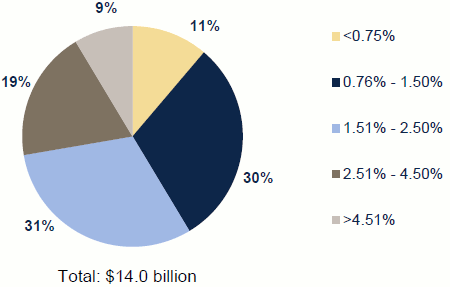Just how risky the outstanding catastrophe bond market is at any one point in time depends on many factors. Different catastrophe bond transactions have different risk factors and some are clearly a riskier investment opportunity than others. There are a number of metrics that help investors identify how risky, or liable to be triggered, a cat bond deal is including the probability of attachment, return period calculations, the coupon payment that is offered and the expected loss.
The latter, expected losses, is a useful metric as it helps to portray the probability of a loss of a certain size occurring on a specific transaction and it is one of the metrics that investors tend to look closely at and even remodel across different risk modellers software tools.
We looked at the expected loss characteristics of the market back in May 2011 when it was found that the weighted average expected loss of cat bonds was steadily rising and had been since the market began in the 1990’s. This was put largely down to investors becoming more familiar with the structures used in cat bonds and so becoming more willing to take on increasing levels of risk if the return was right.
Our article the other day looked at expected loss versus risk premium in non-hurricane and hurricane exposed cat bonds. This shows that there is some correlation between the two as you can see from the graphs that premiums paid rises with expected losses to some degree, however it also showed that at times they are uncorrelated.
So we thought it would be interesting to add to this with another graph from Willis Capital Markets & Advisory’s (WCMA) recent quarterly ILS report which shows the breakdown of the outstanding cat bond market by expected loss.

Non-life catastrophe bond par outstanding by expected loss - Source: WCMA Transaction Database as of June 30, 2012
As we saw in our recent post, the average expected loss of cat bonds including U.S. hurricane so far this year has been 2.4% while the average expected loss of non-U.S. hurricane cat bonds issued this year has been 1.8%. Looking at the chart above it shows that within those averages there must be quite a range of different expected loss amounts with some deals in each grouping being much riskier than others. It’s also interesting to note that in the recent quarter, while expected loss of U.S. hurricane cat bonds has been 2.4% the average risk premium has been 12%, conversely for non-U.S. hurricane deals with an expected loss of 1.8% the average risk premium has been 5.6%.
Without expected loss metrics, and all the other figures which help investors to understand the risk involved in a cat bond or ILS deal, there would likely be no market. Investors need transparency, they need to feel that the modelling undertaken on a transaction has truly identified how risky an investment it may be. The graph above shows that there is a healthy range of expected loss in the outstanding cat bond market which means there is something for investors with a strong appetite for risk (and desire for return) and plenty for those who do not want to take on a risk that is likelier to happen more frequently.
 View all of our Artemis Live video interviews and subscribe to our podcast.
View all of our Artemis Live video interviews and subscribe to our podcast.
All of our Artemis Live insurance-linked securities (ILS), catastrophe bonds and reinsurance video content and video interviews can be accessed online.
Our Artemis Live podcast can be subscribed to using the typical podcast services providers, including Apple, Google, Spotify and more.































